{Click on an image to enlarge, then use the back button to return to this page}
This page last updated on 05/0232020
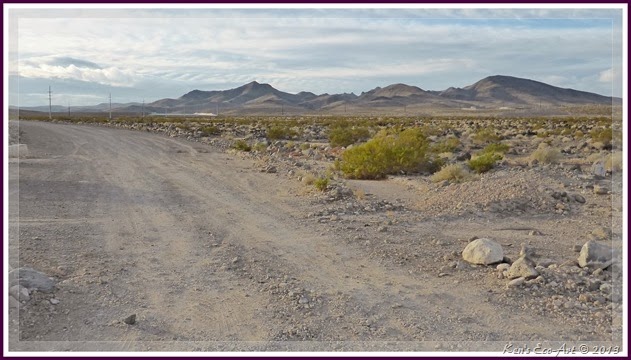 |
| (Fig. 01) |
 |
| (Fig. 02) |
 |
| (Fig. 03) |
Directions: Because this hike was back in 2012, a lot has changed in the area surrounding Sloan Canyon. Since this hike several new roads and hundreds of houses have been built in this area of town. As you can see from (Fig. 01) there was nothing but desert and dirt roads. Back then, coming from St Rose Parkway, you
turned onto Executive Airport Drive. At the intersection (light) of Volunteer Blvd and Via Inspirada, continue straight onto Via Inspirada. This road then curves left onto Bicentennial Parkway. About 2.3 miles from St Rose Pkwy, turn right onto Via Firenza and go to the end. At the junction of Democracy Road, turn right and bypass the barrier onto a dirt road. Work your way west toward the main power line. Follow the power line until you see a two-track dirt road on your left, just before pole number 12084. Follow this road south for approximately 1 mile to a cleared round parking area. From here you exited the parking area on the east side and walked to the Sloan Canyon Wash. Heading due south, you then hiked to the original trailhead and the entrance of Sloan Canyon.
Description of Area: Formed in 2002, the Sloan Canyon National Conservation Area encompasses 48,438 acres of land managed by the Bureau of Land Management (BLM), located only a short distance south of Las Vegas and Henderson, Nevada in the northwestern portion of the McCullough Mountain Range (Fig. 02). It surrounds an additional area that has been designated as the North McCullough Wilderness Area. The Sloan Canyon Petroglyph Site, found in the south western portion, is the centerpiece of this conservation area.
Background and History: The Sloan Canyon Petroglyph Site is one of the most significant cultural resources in Southern Nevada. Archaeologists believe its 318 recorded rock art panels with approximately 1,200 individual petroglyphs were created by native cultures from the Archaic to the historic era. Experts believe the earliest of these were made by ancestral Puebloans in the Archaic period, but other tribes may have continued to add petroglyphs in later years. Archaeological evidence suggests resources within Sloan Canyon may have been used as long ago as 7,000 years. It has been called the Sistine Chapel of Native American rock art due to their size and significance. The rock art in Sloan Canyon is primarily of the Great Basin and Range tradition with abstract elements accounting for the majority of the rock art panels found in the canyon. Anthropomorphs (human-like) and Zoomorphs (animal-like) appear in about equal numbers throughout the canyon. Most of the anthropomorphs and zoomorphs are traditional stick-like figures that are not culturally specific. Some of these have been dated to be more than 900 years old. However, there are two known exceptions to these common stick-like petroglyphs, both of which are historic figures. One appears to be a cowboy holding a rifle and the other appears to be a cowboy riding a horse. It is believed that these may depict contact between Native Americans and early American pioneers during the westward movement. For more information on Sloan Canyon, click the following link ...
Study of Sloan Canyon's Rock Art. Here is a summary page of more than 50 pictures of rock art that I have taken over the years visiting Sloan Canyon ...
Rock Art Photos taken at Sloan Canyon NCA.
 11/21/2013 Trip Notes
11/21/2013 Trip Notes: On today’s visit to this area we approached the area from Bicentennial Parkway. Not only was this a much shorter, easier route, it was accessible by our van. Once we reached the beginning of the road leading to the trailhead, We then began the 1.1 mile hike up the loose gravel filled wash to the petroglyph area. we followed the road about 1.1 miles to the actual trailhead. Just beyond the trailhead (Fig. 03) I walked up the wash to the top of a ridge behind the Kiosk. When I reached the top of the ridge, it provided me with a good view of the wash and Sloan Canyon as it began to narrow on its way to the petroglyph gallery (Fig. 04). As a result, had to return back down to the wash. By then I ran out of time and I never did make it to the site of the petroglyphs on today’s visit.
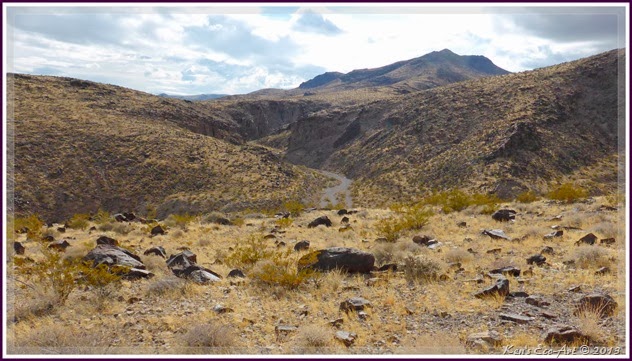 |
| (Fig. 04) |
 02/21/2012 Trip Notes
02/21/2012 Trip Notes: I made this trip with Harvey Smith, one of the regular rock-hound hikers, who volunteered the driving with his new 4x4 truck. The drive along the power line access road was extremely rough and required the four-wheel drive in a couple of spots. Once we reached the trailhead which starts at the beginning of the North McCullough Wilderness Area, the hike up the loose gravel filled wash to the petroglyph gallery was relatively easy, excepting the climb up the last of the three wash-overs.
(Figs. 05 & 06) shows the approach to the third and most difficult of the three scramble ups that we encountered. As you can see in (Fig. 06), there is a huge boulder stuck right I the middle between the two cliff edges. Climbing up the right side, which Harvey chose, was quite steep and then required a jump of nearly 12 feet after you reached the top to get back down to the base of the wash. Climbing the left side, which I opted for, shown in (Fig. 08), was much shorter, however the face of the rocks were as smooth as glass, making it extremely difficult to get any footing. This “staged” photo was taken after my decent on our return trip, showing what it would probably have looked like if Harvey hadn't been there to assist me. (Fig. 07) is a shot from the top of this impediment, looking back down the canyon's narrows. The petroglyphs in (Figs. 09 thru 14) are but a few of the hundreds of ancient etchings in this area. The picture in (Fig. 13) shows harvey hiking near the top of the canyon in the petroglyph area. (Notes continued below)
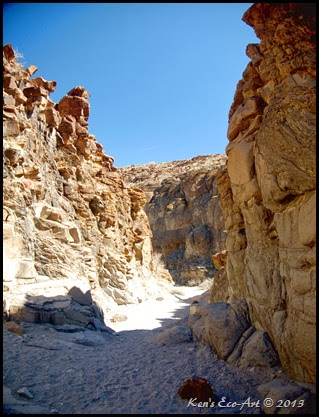 |
| (Fig. 05) |
|
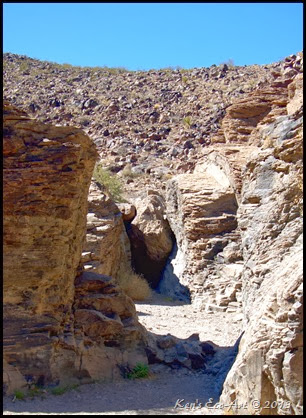 |
| (Fig. 06) |
|
 |
| (Fig. 07) |
|
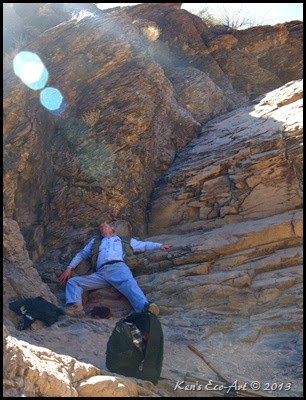 |
| (Fig. 08) |
|
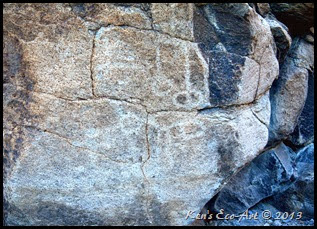 |
| (Fig. 09) |
|
 |
| (Fig. 10) |
|
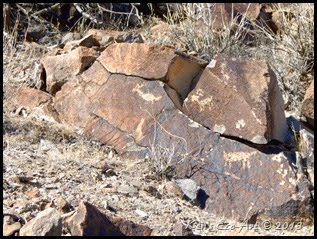 |
| (Fig. 11) |
|
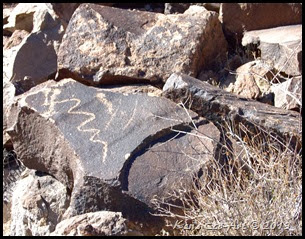 |
| (Fig. 12) |
|
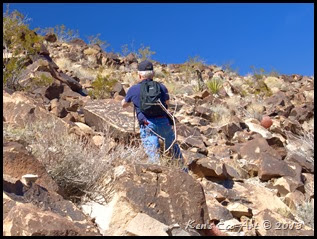 |
| (Fig. 13) |
|
 |
| (Fig. 14) |
|
Notes Continued: After taking dozens of petroglyph pictures in the main gallery area, we continued hiking further up Sloan Canyon wash and a couple of side trails for what was probably another mile and a half. Finding nothing more than a few scenic views, we started our return to the trailhead. The three pictures below (Figs. 15-17) are some of the views we observed in this upper area. (Click here for more ... More Sloan Canyon Petroglyphs).
 |
| (Fig.15) |
 |
| (Fig. 16) |
 |
| (Fig. 17) |
|
|
|
|
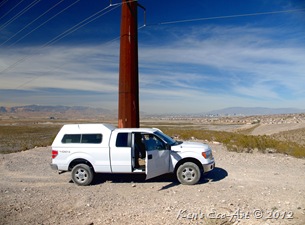 |
| (Fig. 18) |
After leaving the Sloan Canyon National Conservation Area we decided to turn east on the power line road and look for an alternate route out vice going back over the same rough route we took in. After tough four-wheel climb, we reached the highest point in the power line road next to Seven Hills (Fig. 18). The view in (Fig. 19) is looking back toward the "M" Casino. Using his binoculars, Harvey spotted what looked like a possible way out which led us to a place where we were able to “sneak” onto Bicentennial Parkway, just south of the Henderson Airport. Great job Harvey! |
|
 |
| (Fig. 19) |
|



















